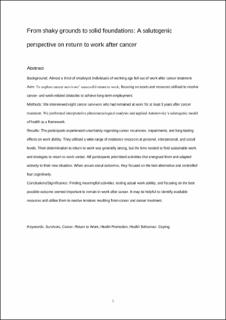From shaky grounds to solid foundations: a salutogenic perspective on return to work after cancer
Peer reviewed, Journal article
Accepted version
Permanent lenke
https://hdl.handle.net/11250/2656580Utgivelsesdato
2019Metadata
Vis full innførselSamlinger
Originalversjon
Scandinavian Journal of Occupational Therapy. 2019, 1-13. 10.1080/11038128.2019.1663922Sammendrag
Background: Almost a third of employed individuals of working age fall out of work after cancer treatment. Aim: To explore cancer survivors’ successful return to work, focusing on assets and resources utilized to resolve cancer- and work-related obstacles to achieve long-term employment. Methods: We interviewed eight cancer survivors who had remained at work for at least 3 years after cancer treatment. We performed interpretative phenomenological analysis and applied Antonovsky’s salutogenic model of health as a framework. Results: The participants experienced uncertainty regarding cancer recurrence, impairments, and long-lasting effects on work ability. They utilized a wide range of resistance resources at personal, interpersonal, and social levels. Their determination to return to work was generally strong, but the time needed to find sustainable work and strategies to return to work varied. All participants prioritized activities that energized them and adapted actively to their new situation. When unsure about outcomes, they focused on the best alternative and controlled fear cognitively. Conclusions/Significance: Finding meaningful activities, testing actual work ability, and focusing on the best possible outcome seemed important to remain in work after cancer. It may be helpful to identify available resources and utilize them to resolve tensions resulting from cancer and cancer treatment
